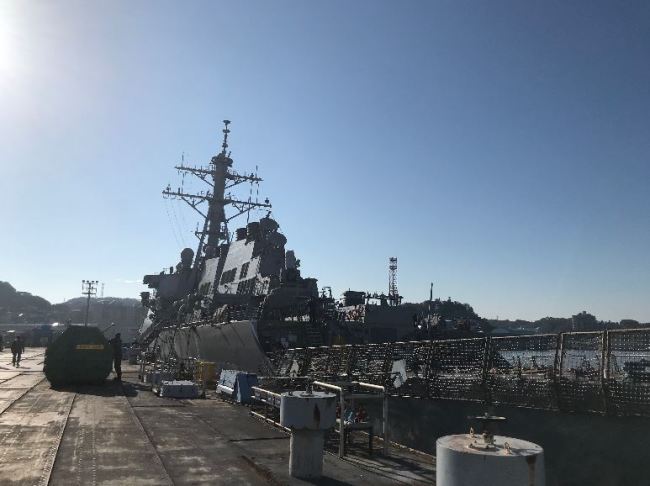YOKOSUKA/OKINAWA/TOKYO -- In the morning of Nov. 29, 2018, hours after North Korea test-fired the Hwasong-15 ballistic missile toward Japan, the US naval base in Yokosuka, Kanagawa Prefecture, was calm with a tinge of uneasiness and tension in the air. It is home to the 7th Fleet, the US Navy’s largest forward-deployed armada.
Led by its command ship USS Blue Ridge, an impressive collection of guided missile cruisers and destroyers were docked at the base, ready to scramble at any moment’s notice.
Sailors and workers were busy carrying equipment and unloading cargo across the 3-kilometer waterfront road at Tokyo Bay.
 |
The USS Curtis Wilbur destroyer is anchored at the dock in Yokosuka naval base. (Yeo Jun-suk/The Korea Herald) |
Although the nuclear-powered aircraft carrier Ronald Regan was nowhere to be seen, the whole dock was crowded with US battleships. Some of them were under the repair, including a USS Fitzgerald destroyer that collided with a Philippine-flagged merchant vessel in June.
“If the missile launch were a real-world scenario and escalated into the war, the whole ships would have scrambled right away. Ronald Reagan aircraft carrier would have been called upon immediately,” said a South Korean military official who accompanied South Korean journalists on a visit here.
The Yokosuka base was part of the Korean media group’s five-day itinerary to the US forces in Japan and UN-designated bases here. Yokosuka is one of the seven UN-designated bases.
The main purpose of the trip was to check on the force flow and logistical support in the event of contingency on the Korean Peninsula.
Also docked here were Ticonderoga-class guided missile cruisers – such as USS Antietam, USS Chancellorsville and USS USS Shiloh. Several aegis-equipped US destroyers and Japanese submarines from the Self-Defense Forces were spotted.
The reporters were granted rare access to USS Curtis Wilbur, Arleigh Burke-class guided missile destroyer. Equipped with Tomahawk missile and Aegis systems, the ship participated in missile warning exercises involving South Korea, Japan and the US, including the one in March.
Throughout the tour, the crew members stressed they were “combat-ready” for contingency on the Korean Peninsula “whenever possible,” although they couldn’t reveal any details about the operations.
 |
A F-15J fighter jet is stored at the hangar in Yokota air base. (Yeo Jun-suk/The Korea Herald) |
There are seven UN-designated bases in Japan: Camp Zama, Yokota air base and Yokosuka on the main island of Honshu; Sasebo naval base on the island of Kyushu; and Kadena air base, White Beach naval facility, Futenma Marine Corps air station on Okinawa.
After the Korean War ended with an armistice in 1953, the United Nations Command Rear was established to support the UNC Command in Seoul. UNC headquarters relocated to Seoul from Tokyo in 1957.
Such roles are enshrined in the US-Japan Security Cooperation Treaty. Its Article V and VI stipulate that the US obligation to defend Japan from “common danger” and Japan’s obligation to provide US access to its facilities and territories.
“United Nations Command and UNC-Rear Command is basically US organizations. They are virtually activated under the US law,” said Narushige Michishita, professor of National Graduate Institute for Policy Studies in Japan.
Among the first units to be dispatched to the Korean peninsula is the 3rd Marine Expeditionary Forces. Headquartered at Futenma base in Okinawa, the forces are able to rapidly conduct operations from humanitarian assistance and disaster relief to amphibious assault and high-intensity combat.
When the reporters visited the Futenma base, dozens of attack aircraft and transport helicopters were spotted at the 3-kilometer-long airfield. Among them were V-22 Osprey tiltrotor military aircraft and CH-53E Super Stallion helicopters.
Military officials said with the help of those assets, the 3rd Marine Expeditionary Forces can be dispatched to South Korea within 24 hours in the event of contingency. Among the 54,000-strong US military personnel in Japan, 28,000 belong to the expeditionary forces.
“Currently, the 3rd Marine Expeditionary Forces are dispatching troops to the combined Korea-US exercise almost every three weeks,” said a military official from the South Korean Marine Forces. “They are possibly the most agile unit.”
Enabling their mission is the United Nations Forces in Japan.
Symbolic of the combined nature of the unit, the USFJ headquarters in Yokota air base have three flags -- those of the US, Japan and the UN -- hoisted at the entrance.
Comprising the USFJ is mostly expeditionary and agile forces from the Air Force, Navy and Marine Corps. About 54,000 troops are assigned throughout Japan. Its number is much higher than the 28,500 US troops stationed in South Korea.
There is one lingering concern in South Korea over the role of Japanese troops when it comes to the contingency on the peninsula -- What if Japan works with the US to devise a preemptive strike plot against North Korea without the consent of the South Korean government?
“The Japanese troops don’t have capability to conduct a preemptive strikes. For example, it is not able to carry out an operation of Suppression of Enemy Air Defense against North Korea,” said Michishita.
“Japan doesn’t have the capability to conduct combined military operations with the US.”
By Yeo Jun-suk (
jasonyeo@heraldcorp.com)









